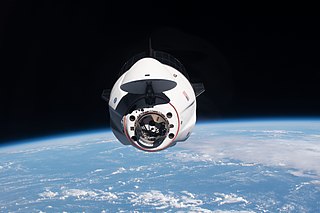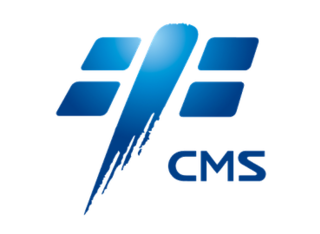
Human spaceflight is spaceflight with a crew or passengers aboard a spacecraft, often with the spacecraft being operated directly by the onboard human crew. Spacecraft can also be remotely operated from ground stations on Earth, or autonomously, without any direct human involvement. People trained for spaceflight are called astronauts, cosmonauts (Russian), or taikonauts (Chinese); and non-professionals are referred to as spaceflight participants or spacefarers.

A space station is a spacecraft which remains in orbit and hosts humans for extended periods of time. It therefore is an artificial satellite featuring habitation facilities. The purpose of maintaining a space station varies depending on the program. Most often space stations have been research stations, but they have also served military or commercial uses, such as hosting space tourists.

Shenzhou is a Chinese spacecraft developed for the nation's crewed space program. Its design was based on Russia's Soyuz, but larger and modernized, Shenzhou is a single-use vehicle composed of three modules. The descent module houses the crew during launch and reentry. The orbital module provides additional living space and storage during orbit but is jettisoned before reentry. The service module, responsible for propulsion and power, is also discarded prior to reentry. For added safety and aerodynamics, the spacecraft is encased within a fairing with a launch escape system during liftoff.

Spaceflight is an application of astronautics to fly objects, usually spacecraft, into or through outer space, either with or without humans on board. Most spaceflight is uncrewed and conducted mainly with spacecraft such as satellites in orbit around Earth, but also includes space probes for flights beyond Earth orbit. Such spaceflights operate either by telerobotic or autonomous control. The first spaceflights began in the 1950s with the launches of the Soviet Sputnik satellites and American Explorer and Vanguard missions. Human spaceflight programs include the Soyuz, Shenzhou, the past Apollo Moon landing and the Space Shuttle programs. Other current spaceflight are conducted to the International Space Station and to China's Tiangong Space Station.
Human spaceflight programs have been conducted, started, or planned by multiple countries and companies. Until the 21st century, human spaceflight programs were sponsored exclusively by governments, through either the military or civilian space agencies. With the launch of the privately funded SpaceShipOne in 2004, a new category of human spaceflight programs – commercial human spaceflight – arrived. By the end of 2022, three countries and one private company (SpaceX) had successfully launched humans to Earth orbit, and two private companies had launched humans on a suborbital trajectory.

Shenzhou 5 was the first human spaceflight mission of the Chinese space program, launched on 15 October 2003. The Shenzhou spacecraft was launched on a Long March 2F launch vehicle. There had been four previous flights of uncrewed Shenzhou missions since 1999. China became the third country in the world to have independent human spaceflight capability after the Soviet Union and the United States.
A mission patch is a cloth reproduction of a spaceflight mission emblem worn by astronauts and other personnel affiliated with that mission. It is usually executed as an embroidered patch. The term space patch is mostly applied to an emblem designed for a crewed space mission. Traditionally, the patch is worn on the space suit that astronauts and cosmonauts wear when launched into space. Mission patches have been adopted by the crew and personnel of many other space ventures, public and private.

The following outline is provided as an overview of and topical guide to space exploration.

The China Manned Space Program, also known as Project 921 is a space program developed by the People's Republic of China and run by the China Manned Space Agency (CMSA) under the Equipment Development Department of the Central Military Commission, designed to develop and enhance human spaceflight capabilities for China. It was approved on 21 September 1992 and has been in operation ever since. The CMS commander and director are currently Xu Xueqiang and Zhou Jianping respectively; the latter has held this position since 2006, after taking over from Wang Yongzhi, who served as the first director from 1992 to 2006.

Shenzhou 12 was a Chinese spaceflight to the Tiangong space station, launched on 17 June 2021. It carried three People's Liberation Army Astronaut Corps (PLAAC) taikonauts on board a Shenzhou spacecraft. The mission was the seventh crewed Chinese spaceflight and the twelfth flight overall of the Shenzhou program. It was the first flight to Tiangong, and the first Chinese crewed spaceflight since Shenzhou 11 in 2016.







